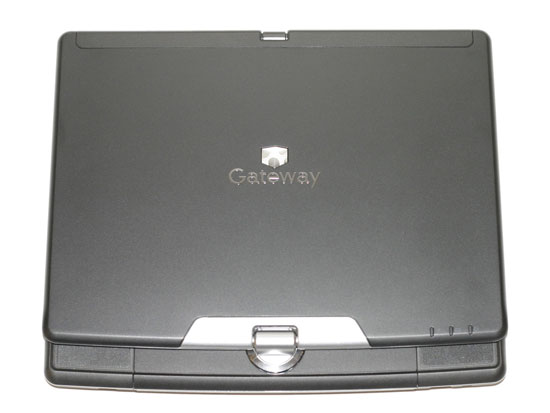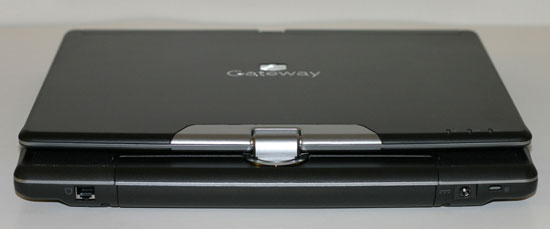Gateway E-155-C: A Lightweight Convertible
by Jarred Walton on July 4, 2007 12:05 AM EST- Posted in
- Laptops
Design and Appearance
Performance, features, size, and/or weight are usually the primary considerations for people out notebook shopping. Appearance is another factor that may or may not be important, and the overall design needs to be evaluated to see how it works in day-to-day use.
We would characterize the appearance in general as utilitarian. It's not really ugly, but at the same time there's nothing to set it apart from other notebooks. You get a charcoal gray laptop that looks about the same as many other laptops. Those who are looking for a beauty queen will want to keep searching, but before you write off the E-155-C you might want to take a closer look at the design.
One of the selling points is that you can convert the E-155-C from a standard laptop into a tablet PC. (Note that in the above image the laptop is technically upside down; the screen orientation is automatically flipped when you convert the system into tablet mode, but we liked having the Gateway logo right side up.) The E-155-C might be thicker than a pure-tablet design, but we would be hard-pressed to give up access to a keyboard on any computer. Perhaps a combination of using a tablet interface along with speech recognition could suffice, but we did try exactly that and came to the conclusion that there are still plenty of times where having access to a keyboard and mouse is practically a necessity.
Looking at the laptop from various angles, we can see many of the features highlighted on the previous page. There are no ports or connections on the front of the laptop. The only item worth mentioning is the button that releases the display. The latch for the display can be flipped either direction so that it will also lock into place in tablet mode.
The rear is similarly barren. On the right side (left when you're facing the front of the laptop) is the power socket and Kensington lock, while on the other side is a telephone jack. (Our condolences if you still have to use such a connection.) The battery slides out of the back of the unit, and the larger battery sizes protrude slightly farther than what you see in the above image. The battery design actually works very well, and using a larger battery doesn't make the notebook any more awkward to handle. This is not the case with some other notebooks, where larger batteries can end up protruding from the bottom of the case and give the laptop a bulky feel.
The left and right sides as usual house the majority of the connections. On the left you will find a VGA port, the docking connector, Ethernet, a PC Card type II expansion slot, and a 6-in-1 flash memory reader (MS/MS Pro, MMC/RS-MMC, SD/Mini-SD). While the inclusion of an older PC Card slot as opposed to a new ExpressCard slot seems a bit odd at first, the primary market for the E-155-C appears to be business users, and many large corporations and businesses have various PC card peripherals that they continue to use. Near the front of the laptop, we also find the home for the stylus.
The right side houses the optical drive, which takes up the majority of the space. Near the rear are microphone and headphone jacks, while towards the front are two USB ports and a mini FireWire port.
Performance, features, size, and/or weight are usually the primary considerations for people out notebook shopping. Appearance is another factor that may or may not be important, and the overall design needs to be evaluated to see how it works in day-to-day use.
 |
We would characterize the appearance in general as utilitarian. It's not really ugly, but at the same time there's nothing to set it apart from other notebooks. You get a charcoal gray laptop that looks about the same as many other laptops. Those who are looking for a beauty queen will want to keep searching, but before you write off the E-155-C you might want to take a closer look at the design.
 |
One of the selling points is that you can convert the E-155-C from a standard laptop into a tablet PC. (Note that in the above image the laptop is technically upside down; the screen orientation is automatically flipped when you convert the system into tablet mode, but we liked having the Gateway logo right side up.) The E-155-C might be thicker than a pure-tablet design, but we would be hard-pressed to give up access to a keyboard on any computer. Perhaps a combination of using a tablet interface along with speech recognition could suffice, but we did try exactly that and came to the conclusion that there are still plenty of times where having access to a keyboard and mouse is practically a necessity.
 |
 |
Looking at the laptop from various angles, we can see many of the features highlighted on the previous page. There are no ports or connections on the front of the laptop. The only item worth mentioning is the button that releases the display. The latch for the display can be flipped either direction so that it will also lock into place in tablet mode.
The rear is similarly barren. On the right side (left when you're facing the front of the laptop) is the power socket and Kensington lock, while on the other side is a telephone jack. (Our condolences if you still have to use such a connection.) The battery slides out of the back of the unit, and the larger battery sizes protrude slightly farther than what you see in the above image. The battery design actually works very well, and using a larger battery doesn't make the notebook any more awkward to handle. This is not the case with some other notebooks, where larger batteries can end up protruding from the bottom of the case and give the laptop a bulky feel.
 |
 |
The left and right sides as usual house the majority of the connections. On the left you will find a VGA port, the docking connector, Ethernet, a PC Card type II expansion slot, and a 6-in-1 flash memory reader (MS/MS Pro, MMC/RS-MMC, SD/Mini-SD). While the inclusion of an older PC Card slot as opposed to a new ExpressCard slot seems a bit odd at first, the primary market for the E-155-C appears to be business users, and many large corporations and businesses have various PC card peripherals that they continue to use. Near the front of the laptop, we also find the home for the stylus.
The right side houses the optical drive, which takes up the majority of the space. Near the rear are microphone and headphone jacks, while towards the front are two USB ports and a mini FireWire port.










25 Comments
View All Comments
DEMO24 - Wednesday, July 4, 2007 - link
stylus is the only way to make commands work on the screen.also if you configure the stylus right, then having the issue mentioned in the article is not a problem.
I carry a tablet around where I work. While I don't use the tablet function, its been pretty damn reliable. They seem to be a bit more durable than a normal laptop. This thing has seen its fair share of abuse, and it's never missed a beat.
JarredWalton - Wednesday, July 4, 2007 - link
You can interface with the display using a finger, but for a variety of reasons I would definitely recommend the stylus. You get better accuracy, you can easily click or right-click, and you don't leave fingerprints everywhere.Vidmar - Wednesday, July 4, 2007 - link
Page 10: The chart says "Batter Life". I guess you can't have your cake and eat it too! ;)Vidmar - Wednesday, July 4, 2007 - link
I wonder if you could get better battery life under XP tablet instead of Vista? Our E-155Cs are getting ~240-260 mins of battery life with the six cell battery under XP tablet while doing routine tasks and the display fully bright. (Which I agree is necessary)Also you had mentioned in the article that the display would dim sometimes all on its own. There is a BIOS option, ALS control (Ambient Light Sensor) that allows the machine to control display brightness using a sensor on the laptop. This reason for this option is when you would want/need to use it in daylight. The sensor senses the extreme brightness of daylight and lowers the brightness of the display so that it can be read in full sunshine. Unfortunately I think it’s a bit more sensitive and can also lower the display brightness when it really should not. This can be simply disabled in the BIOS.
JarredWalton - Wednesday, July 4, 2007 - link
It wouldn't surprise me if XP lasts a bit longer in terms of battery life. Vista seems like it tends to keep the CPU in a higher performance state, at least on other laptops. The HP dv6500t, for example, rarely ran at lower than 1.6 GHz, even though it could go as low as 800 MHz (or perhaps 1 GHz?). One of these days I'll have to do a better XP vs. Vista laptop comparison, just to see how things stand.MercenaryForHire - Wednesday, July 4, 2007 - link
Or at least beaten with a hose. I haven't used a telephone cable for anything other than the household phone for about ten years.And while the forward location of the (only) two USB ports makes it easy to pop in a memory stick or other peripheral, it makes using a mouse more than a slight nuisance as the cord will have to snake backwards across the optical drive.
Vidmar - Wednesday, July 4, 2007 - link
One aspect of this table pc that was missing from this article was that it also can be configured with Bluetooth. A Bluetooth mouse is the perfect companion for this machine. No wires, USB wireless adapters necessary.bldckstark - Friday, July 6, 2007 - link
USB wireless mouse = $12Bluetooth mouse = $80
Extra 3lbs of batteries you have to carry for the Bluetooth mouse = Priceless
At least that's what my Chiropracter said.
If you have to plug in a USB device to run your mouse, why not just use a wired one? Why bother with the batteries.
Visual - Wednesday, July 4, 2007 - link
that laptop is utter crap, it seems.only people that really want something ultra-light and don't care for performance at all would be interested... and they would be better off with a pda or smartphone, with an additional portable keyboard if they need a lot of typing.
i dont understand why laptop makers don't make a decent convertible - at least 13-15", with reasonable graphic card and all... and even bigger laptops, even if they're not too comfortable for holding in one hand can still benefit from a touchscreen and a tablet-like folding.
Vidmar - Wednesday, July 4, 2007 - link
This laptop/tablet is for those who need to run a queries against an database, while programming that new interface for the next rev of the accounting app, while reading their email, while taking notes tablet style, all while connected to the corporate VPN and never having to touch an electrical outlet for ~4.5 hours in those day long meetings.Do that on your PDA.